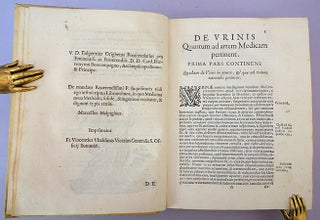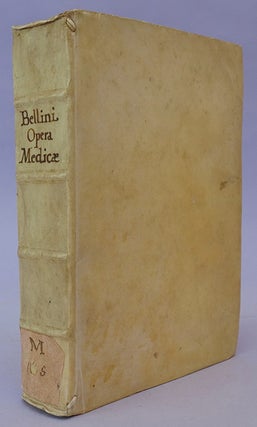De urinis et pulsibus de missione sanguinis de febribus de morbis capitis, et pectoris. Inscribed Presentation Copy.
Publisher Information: Bologna: ex typographia HH. Antonij Pisarrii, 1683. First edition.
Inscribed by Bellini
Bellini, Lorenzo (1643-1704). De urinis et pulsibus de missione sanguinis de febribus de morbis capitis, et pectoris. 4to. [20], 606 [i.e., 608]pp. Woodcut ornaments. Bologna: ex typographia HH. Antonij Pisarrii, 1683. 216 x 161 mm. Vellum c. 1683, title hand-inked on spine. Leaf Aaaa2 torn and repaired at an early date without loss of text, otherwise a fine copy. Presentation copy from the author, inscribed at the foot of the title: "All' Illmo Conte Tommaso della Gherardesca. l'Autore."
First Edition, inscribed by the author. This is the first inscribed copy of a major seventeenth century medical classic that has been on the market in more than a decade. Bellini, professor of anatomy and medical theory at Pisa, was one of the Italian founders of iatromechanics, a system that framed physiologic events such as the circulation of the blood in terms of mathematical and physical principles. Bellini's De urinis et pulsibus represents the first important attempt by an Italian scientist to systematically apply iatromechanics to medical theory. "William Harvey's theory of the circulation was of fundamental importance to Bellini and other proponents of iatromechanism. Bellini asserted that good health depended on optimal function of the circulation of the blood, and that disease was a manifestation of an inefficient circulation. Rejecting ancient humoral pathology, he viewed blood as a physical fluid with specific properties that could be interpreted in terms of mathematical and physical principles. . . . Bellini emphasized that disease was often due to alterations in the elasticity or 'tone' of the solids, or in the density of the fluids which hindered their motion. This, in turn, could cause local congestion or stagnation. Bellini's enthusiastic support of therapeutic bleeding reflected this pathophysiologic concept. He tried to prove that this phlebotomy increased the velocity of the circulation, thereby washing away 'morbid matter' and restoring health" (Fye, pp. 181-82).
In the book's section on diseases of the chest, Bellini reported "several forms of heart disease, especially of the syncopal type . . . in his book De urinis et pulsibus, Bellini discusses the state of the coronary arteries and admits that the condition which he calls 'pressio' is dangerous and may cause the contraction of the heart to be abolished (p. 541). He also has in mind external pressure by tumors, fat and so on. However, an intra-arterial coronary impediment of blood-flow by calcification was clearly described by this author. Bellini reported of a patient who died of a condition similar to the clinical picture of coronary disease as we now understand it, in whose coronary arteries he found a 'stone.' It seems quite reasonable to deduce that Bellini saw in the post-mortem a coronary occlusion" (Leibowitz, History of Coronary Heart Disease, p. 71).
Bellini's work is also important in the history of urology, as it marks the first important contribution to the chemical analysis of urine. Recognizing the value of urine as a diagnostic aid, Bellini insisted on its chemical analysis in pathologic conditions.
Bellini presented this copy of De urinis et pulsibus to Tommaso della Gherardesca (1654-1721), a distinguished member of an important Tuscan aristocratic family and as such a likely patron. Gherardesca was appointed bishop of Fiesole in 1702 and archbishop of Florence in 1703; he also founded the Seminario Maggiori di Firenze in 1712. The rarity of this inscription by Bellini cannot be overestimated. This is the first inscribed book by Bellini we have seen on the market in more than 40 years and it is also the first inscribed copy of a major seventeenth century classic on any aspect of medicine that we have seen on the market in more than a decade, possibly longer. In addition this copy is clearly in the original binding in which it was presented, and with the exception of one leaf, which was inexplicably torn through and repaired, the copy is in fine, even very fine condition for a work of this period
.Garrison-Morton 762.1, 4162. Fye, "Lorenzo Bellini," Clinical Cardiology 20 (1997): 181-82. Dictionary of Scientific Biography. Willius & Dry, History of the Heart and the Circulation, p. 64. Murphy, History of Urology, pp. 147-48.
Book Id: 40699Price: $9,500.00




